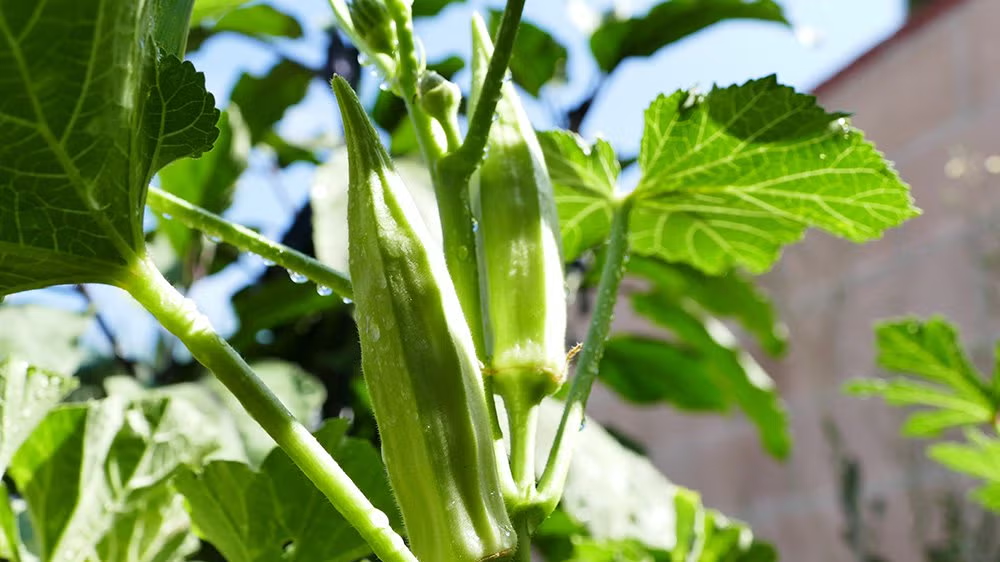
Okra is a Southern Garden Staple
Learn how to grow okra in your garden—from planting seeds to caring for your plants and harvesting your crop!
Okra loves warm weather and is a favorite in the southern U.S. It grows best in hot summers and needs temperatures consistently above 70°F.
Okra grows on tall stalks, producing big, hibiscus-like flowers that eventually turn into edible pods—the part we eat!
Also known as lady fingers or gumbo, okra is beginner-friendly and a must-have in Southern gardens.
Want to grow your own? Keep reading to find out how to add this tasty veggie to your garden!
Okra Varieties to Try
Most modern okra varieties are “spineless,” meaning the pods don’t have the prickly fuzz found on older types.
Here are some of my top picks—two green and two red varieties:
- Clemson Spineless – The most popular okra variety, known for fast growth and heavy yields. Spineless and easy to handle.
- Annie Oakley II – A compact hybrid (around 4.5 ft tall) with quick-maturing, spineless pods.
- Burgundy – An open-pollinated variety with striking red stems and tender, mild pods.
- Jung Orange – Another red okra that produces large (6-8 inch), tender pods. The plants get big and yield heavily.
*In warm climates with long growing seasons, okra can reach 6-8 feet tall!*
When to Plant Okra
Okra thrives in heat, so don’t rush planting!
- Starting seeds indoors? Begin about 3 weeks before your last frost date.
- Direct sowing? Wait until 3-4 weeks after your last frost, when nights stay above 65°F.
- Soil temps should be at least 65°F—the warmer, the better!
Preparing Your Okra Bed
Okra isn’t picky—it’ll grow in poor soil but does best with added organic matter.
- Ensure good drainage (okra hates soggy roots!).
- Planting where peas grew is a smart move—the nitrogen they leave behind helps okra thrive.
- Most importantly: Pick a full sun spot—okra loves sunshine!
Growing Okra from Seed to Harvest
Okra is easy to grow from seed—it sprouts quickly and grows fast.
You can start seeds indoors (better control) or sow directly outside. I prefer starting indoors for stronger seedlings.
Starting Okra Seeds Indoors
- Plant seeds ½ inch deep in seed trays with quality soil.
- Keep soil moist until sprouts appear.
- Use a heat mat if your home is cool.
- Place in sunlight or under grow lights.
- Transplant outside 3-4 weeks after the last frost, spacing plants 15 inches apart.
Direct Sowing Okra
- Wait until nights are at least 65°F (3-4 weeks after last frost).
- Soaking seeds overnight helps germination.
- Space seeds 15 inches apart, rows 3 feet apart.
- In the South, you can plant two crops—one early (started indoors) and one in late June.
- In cooler climates, use cold frames or wait until June for warm soil.
Caring for Okra
Okra is low-maintenance but benefits from:
- Weed-free beds (especially when plants are young).
- Minimal watering—okra is drought-tolerant (only water if plants wilt in extreme heat).
- Mulch to retain moisture and suppress weeds.
Pests & Diseases
Okra is tough, but cool weather can stress plants, making them prone to:
- Fusarium wilt
- Aphids
- Stink bugs
- Root knot nematodes
- Corn earworms
Solutions: Crop rotation and organic pest control usually work.
Companion Plants for Okra
Pairing okra with the right plants helps reduce pests and maximize space:
- Lettuce – Grows well at the base, shading soil and suppressing weeds.
- Peas – Fix nitrogen in the soil before okra takes over.
- Sunflowers – Act as a trap crop, luring pests away from okra.
When to Harvest Okra
Okra grows fast—ready in 50-60 days on average.
- Flowers appear around 6 weeks, followed by pods.
- Harvest pods young and often (3-4 inches long) to keep them tender and encourage more growth.
- Pick every 2 days to prevent tough, woody pods.
How to Harvest Okra
Okra requires careful handling:
- Wear gloves and long sleeves—even spineless varieties have irritating spines on stems.
- Use scissors or pruners to cut pods cleanly from the plant.
Storing & Preserving Okra
Got a big harvest? Here’s how to keep it fresh:
Short-Term Storage
- Refrigerate unwashed pods in a plastic bag (washed okra molds faster).
- Use within a few days—blackening means they’re past prime.
Long-Term Preservation
- Freezing – Blanch for 3 minutes, cool, then freeze whole or sliced.
- Dehydrating – A great way to preserve okra for snacks or soups.
- Canning – Pressure-can plain okra or water-bath pickle it.
Okra Recipes to Try
Need ideas for your harvest? Check out these recipes:
- Perfect Fried Okra
- Sautéed Okra with Garlic & Onions
- Grilled Okra
- Chicken, Shrimp & Okra Gumbo
FAQs About Growing Okra
Can okra grow in containers?
Yes! Use a 10-inch pot (or a 5-gallon bucket) for best results.
Can okra grow in cold climates?
If you have 60-70 days of 70°F+ weather, yes! Use cold frames or greenhouses to extend the season.
Does okra grow in shade?
No—it needs full sun (or at least most of the day in sunlight).
Can I save okra seeds?
Absolutely! Okra seeds are easy to save—here’s how: How to Save Okra Seeds.
